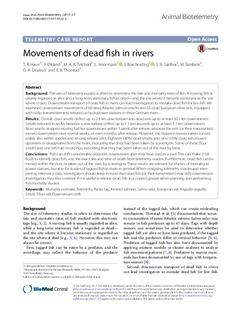| dc.description.abstract | Background: The aim of telemetry studies is often to determine the fate and mortality rates of ish. A moving ish is usually regarded as alive and a long-term stationary ish as dead—and the site where it became stationary as the site where it died. Downstream transport of dead ish in rivers can lead investigators to mistake dead ish for live ish. We examined downstream movements of 60 dead Atlantic salmon smolts and 55 dead European silver eels, equipped with radio transmitters and released at hydropower stations in three German rivers. Results: Overall, dead smolts drifted up to 2.4 km downstream and dead eels up to at least 30.1 km downstream. Smolts released in an Archimedes screw turbine drifted up to 1.1 km and eels up to at least 5.1 km downstream. Most smolts stopped moving further downstream within 1 week after release, whereas the eels (or their transmitters) moved downstream over several weeks, or even months, after release. However, the distance moved varied considerably also within species and among release sites. Eighteen (30%) dead smolts and nine (16%) dead eels moved upstream or disappeared from the rivers, indicating that they had been taken by scavengers. Some of these (four smolts and one eel) had recordings, indicating that they had been taken out of the river by birds. Conclusions: Fish can drift considerable distances downstream after they have died in a river. This can make it dificult to identify dead ish, and the exact site and time of death from telemetry studies. Furthermore, dead ish can be moved within the river, or taken out of the river, by scavengers. These results are relevant for studies of mortality at power stations, but also for studies of tagged ish in rivers in general. When designing telemetry studies and interpreting telemetry data, investigators should keep in mind that dead ish (or their transmitters) may drift downstream. Investigators may also consider if it is useful to release dead ish as a control groups when planning and performing ish mortality studies. Keywords: Mortality estimate, Telemetry, Radio tag, Atlantic salmon, Salmo salar, European eel, Anguilla anguilla, Smolt, Silver eel, Downstream drift | nb_NO |

